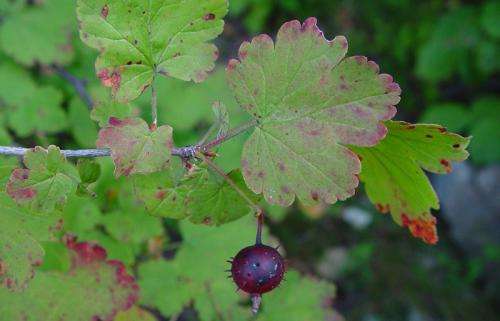Researchers outline plan to save threatened gooseberry

The Miccosukee gooseberry is on the verge of extinction, but geneticist Eric J. B. von Wettberg believes genetic variation is the key to its survival.
The plant, which has been listed as a federally threatened species for nearly three decades, is found in only in Jefferson County, Fla and McCormick County, S.C. today.
"This shrub is so rare we need to actively manage and protect what's left in order to steward the remaining genetic variation," said von Wettberg, a professor in the Department of Biological Sciences. "Strong genetic variation, which allows a plant to adapt to changing climate, is key to its long-term potential."
While Miccosukee or other American Indians may have dined on the gooseberry, it is believed that mastodons, who created open spaces where shrubs thrived, or passenger pigeons, who ate the berries and then dispersed the seeds, were the primary consumer. The extinction of both of these animals may have contributed to the decline of the Miccosukee gooseberry.
"At this point, the species is so close to extinction it's difficult to tell how it was used, and I was surprised we found any genetic variation at all," von Wettberg said.
The research team assessed the genetic diversity of Miccosukee gooseberries across Florida and South Carolina. They found the overall genetic diversity of the species is low, which is problematic because it reduces the ability of species to adapt to environmental changes. They found genetic differentiation between populations is high, suggesting the two populations are sufficiently different so they need to be managed separately. The scientists also found no evidence of strong clonality, meaning this species reproduces asexually and has less genetic variation making its future even grimmer.
According to the researchers, actively conserving a species with small and isolated populations is important because it is expected to lose genetic variation over time which increases its risk of extinction. Small populations also might experience an increase of inbreeding, which can result in poor growth and poor seed production.
"Knowledge of a species' genetics can inform conservation and restoration initiatives in order to minimize the extinction risk by maintaining genetic diversity," von Wettberg said. "Our results should be used as a starting point to better understand the genetic implications towards the conservation of this species."
The research article, titled "Population genetics of the Federally Threatened Miccosukee gooseberry (Ribes echinellum), an endemic North American species," was published February 2014 in Conservation Genetics.
Gooseberry bushes produce an edible fruit and are grown on both a commercial and domestic basis. Gooseberries can be eaten, made into fruit wines and used as an ingredient in desserts, pies or syrup. They can also used to flavor beverages or preserved in the form of jams or dried fruit.
More information: "Population genetics of the Federally Threatened Miccosukee gooseberry (Ribes echinellum), an endemic North American species." Nora H. Oleas, Eric J. B. von Wettberg, Vivian Negrón-Ortiz. Conservation Genetics. February 2014, link.springer.com/article/10.1007%2Fs10592-014-0575-2
Journal information: Conservation Genetics
Provided by Florida International University


















